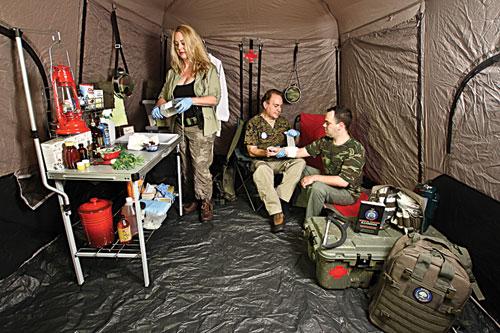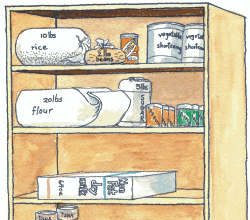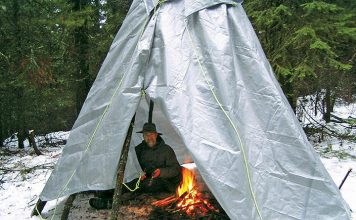| Issue #151 • January/February, 2015 |
For several months now, news regarding the devastation that the Ebola virus is causing in West Africa has been in the headlines. A disease once found only in the most remote regions of the continent, this time Ebola hit capital cities with large airports that could, theoretically, export the virus rapidly throughout the civilized world.
Ebola is just one of the many infectious diseases for which the family medic must be prepared. Even in West Africa, many more have died of malaria and dysentery than have succumbed to Ebola. A strategy must be formulated that would prevent infectious diseases from ravaging your family.
Medical preparedness
We have become quite dependent on the modern technology that has eliminated infectious diseases in many areas. Antibiotics are in their third and fourth generations and new antiviral drugs are now available. These are used liberally in both humans and livestock; physicians don’t hesitate to use them when necessary, leading to consequences both good and bad.
There are very few who realize that a major disaster may eliminate the ability to manufacture these drugs. The average citizen feels a certain invincibility with regards to their health due to the availability of modern medicine. This attitude is not only foolhardy but dangerous when it comes to infectious disease. Medical preparedness is not a goal reserved only for conspiracy theorists; indeed, it is only common sense to be ready to deal with medical issues associated with catastrophic events.
The medic for a family or group has various responsibilities. These include medical officer, counselor, dental care provider, and quartermaster of medical supplies. Perhaps the most important duty, however, is that of sanitation officer. It is their responsibility to make certain that conditions at their home or camp do not allow the invasion of infectious diseases.
Microbes that cause infectious diseases are known as pathogens. Germs may be bacteria, viruses, or protozoa. Bacteria can live and reproduce on their own in many cases, but viruses are only “alive” and reproduce in a host. Parasitic protozoa live in streams and other bodies of water and cause diarrheal disease when improperly sterilized fluids are ingested.
Pathogens are often carried by “vectors.” These are microbes, animals, or persons that carry and transmit a disease to others. These vectors may or may not be ill themselves a mosquito can carry the organism that causes malaria to humans, while having no signs of the disease. “Typhoid Mary” was a domestic servant who carried typhoid fever to many other people without having signs of it herself.
With Ebola, the vector is probably an African fruit bat. It doesn’t get sick, but people who eat plants laden with the bats’ droppings do. Some animals, like apes, can get sick from Ebola and are highly contagious if ingested bats and monkeys are part of the diet in West Africa.
General prevention
It’s logical that the healthier you are, the less likely you are to catch an infectious disease. The standard medical recommendations apply here:
- Eat a healthy diet.
- Get plenty of sleep.
- Avoid stress.
- Stay hydrated.
- Eliminate bad habits like smoking.
- Boost your immune system with vitamins, minerals, and natural supplements.

The medic must put together a room to separate the sick from the healthy.
The medic’s strategy
The following duties will be useful in preventing the spread of Ebola, but they are useful for any other infectious disease.
Enforce hygiene standards: Your group will be most likely to remain healthy if you enforce strict hand and respiratory hygiene. Proper hand hygiene involves a healthy supply of soap and alcohol-based hand sanitizers.
Hand washing should be performed in the following manner: Lather up, wash the palms first, then the back of the hands, and finally between the fingers and under the nails. This should be done for 20-30 seconds each time.
Hand washing should occur before and after eating, after using the bathroom, after sneezing or coughing, and before and after treating patients. During epidemics, hand washing should be performed even after shaking hands.
Respiratory hygiene involves covering your mouth and nose with a tissue when coughing or sneezing, rapid disposal of the tissue, and hand washing. If tissues aren’t available, don’t use your hands to cover your mouth and nose, use your upper arm instead.
Use a mask if coughing. Although others caring for the sick individual may wear masks (N95 masks are affordable and best for healthcare providers), it is most important for the afflicted person to wear one. Sick patients who are coughing and sneezing should stay four feet away from healthy individuals, as infectious droplets can carry that far.
General hygiene and washing of clothes is also very important to prevent issues like body lice. These aren’t fatal, but they can be a constant irritant to group members at times when they have to be at 100% efficiency.
Sterilize water: Clean water is important for safe drinking and preparation of food. This can be accomplished in various ways. There are large commercially-manufactured filters available, as well as portable ones. If you don’t have these, there are several ways to sterilize water using simple methods.
Chlorine bleach is an effective way to sterilize water. Two drops of bleach per quart of water will suffice, but use 4 drops if the water is cloudy. Wait 30 minutes before using. Of course, bleach doesn’t remove particles of debris.
For removal of particulates, you can place washed sand, gravel, and rocks in graduated layers separated by cloth in a two-liter bottle with the bottom cut out. It should be noted that bleach degrades over a short time and should be re-constituted daily for safest use. Solid calcium hypochlorite (68%) may be useful for long-term storage. This can be constituted into bleach by adding¼ ounce of granules to 2 gallons of water.
Iodine: 12-16 drops of iodine 2% tincture per gallon may also be useful to sterilize water.
Boiling: If you can make a fire, bring questionable water to a vigorous boil for one minute to kill most disease-carrying organisms. Some sources recommend a longer time. This water has a very flat taste, which can be improved with aeration by pouring the water several times from one container to another.
Sunlight: Sunlight’s ultraviolet rays will also sterilize water. Fill a 2-liter bottle 80-90% full with water that has been filtered of particles, shake well for 20 seconds, and leave in full sunlight for 6-8 hours.
Prepare food: Oftentimes, disease-causing organisms are present on the outside of fruits and vegetables. Use clean, drinkable water to thoroughly rinse these before cooking. Meats must be fully and evenly cooked at specific temperatures to make them safe. In West Africa, food is often cooked over 55-gallon oil drums. This makes it very difficult to evenly cook food, and may have led to the first Ebola cases.
A meat thermometer is an important item for the survival/homestead kitchen. Cooking temperatures for various meats are:
- Fish and beef: 145° F
- Pork: 150° F
- Ground meats and lamb: 160° F
- Poultry, sauces, gravy, and soups with meat: 165° F
Safely dispose of human waste: Improper disposal of human waste is a major cause of the spread of Ebola and other infectious diseases and a sure way to cause problems for the medic.
If there is available water, even unfit to drink, a toilet in your home that is rendered non-functioning due to grid loss can still work for you. Fill the tank with water before flushing; add a couple of gallons into the toilet bowl after using it. This activates the siphoning mechanism of the plumbing.
Warning: Blocked sewer mains and septic tanks may render this method ineffective. This is due to “backflow.” Some homes have backflow prevention valves; find out if yours has them.
If there is no water, you can still use your non-functioning toilet. Empty it and place two layers of sturdy garbage bags inside; lowering the lid will keep them in place. Once you have used it, pour sand and, optionally, a small amount of very dilute bleach over the excrement for deodorization. Don’t use pure bleach, which may eat through the plastic. Kitty litter is an acceptable alternative. After a few uses, you can dispose of the waste, which is already bagged.
Your ancestors performed these bodily functions outside, for good reason. You may be well-served by doing the same if the grid is down. Obtain a five-gallon bucket from a hardware store. Line it with two garbage bags and place your toilet seat, two short boards, or even a “luggable loo” on top. The “luggable loo” is a top made specifically for turning a five-gallon bucket into a toilet. Use sand, kitty litter, dirt, or quicklime to cover. Dispose of the bag when it is half full.
If you are in charge of a community in an off-grid setting, consider constructing a communal latrine. Dig a trench three feet deep, one foot wide, and 12-15 feet long. Place two planks on either side for support during use, and have a shovel and dirt from the trench available to cover the excrement. Fill in once the dirt has reached the one foot level. For privacy, some type of barrier should be constructed. Make sure that the latrine is at least 200 feet from your water source. A raised area may be best if the water table in your area is close to ground level. Sunlight will help speed decomposition.
Prepare a sick room: The medic must put together a room to separate the infected from the healthy. In a sick room, the furnishings should be minimal: A work surface, a cot (or cots), and a chair may be all that’s necessary. Flooring and work surfaces should not be fabric, as you’ll need areas that can be easily decontaminated with dilute bleach solution.
The room or tent should be well-ventilated and lit. It should be as far away from common areas, such as kitchens, as possible. Outside the entrance should be a work station with a basin, soap, water, and alcohol-based hand sanitizer. A door or other barrier is useful.
If a highly contagious disease is of concern, plastic sheeting may be appropriate to cover bedding and other areas where blood, vomit, or feces may land. Bedding, towels, and eating utensils should be designated for the sick individual, and washed separately from materials used by others. A separate bathroom is a plus.
Only the medic should be involved for caring for the sick and the maintenance of the hospital room. This will serve to decrease the chance of contagion. Those with injuries should be cared for separately from those who are sick with infectious illnesses.
Disinfection of sick room surfaces can be easily accomplished by daily cleanings with bleach solution. A 1:100 bleach solution will be effective in routine washing of floors, work surfaces, and other items used by the sick. A stronger 1:10 solution is appropriate for spills of blood, vomit, feces, urine, and other bodily fluids, especially in cases of Ebola.
Social distancing
Highly deadly infectious diseases like Ebola or the plague are reasons for vigilance when the epidemic is far away, but what additional precautions may be needed if a community-wide outbreak occurs in your area? In extreme circumstances like this, the concept of “social distancing” may be appropriate.
Social distancing is the act of avoiding areas with gatherings of groups of people. Municipalities have a social distancing policy, in which schools, workplaces, and events may be canceled or closed until the outbreak is under control. Personal social distancing includes wearing masks; sequestering in your home; avoiding shaking hands, hugging, or other social niceties; and the storage of food and supplies for an extended time. I recommend staying away from hospitals or emergency rooms. During epidemics, these will be full of infected individuals.
Some prefer to use ammonia, but don’t mix ammonia and bleach, which is a toxic combination which releases dangerous fumes (chloramine) and liquids (hydrazine) which, in pure form, could even be explosive. The vapors are especially damaging to eyes and lungs. Leave the area immediately and, later, hose down the area thoroughly with water if possible.
Stock medical supplies: In the case of infectious disease, equipment for the medic should include:
- coveralls (with head and shoe covers)
- masks (N95 or N100)
- goggles/face shields
- nitrile gloves (many are allergic to latex)
- duct tape
- aprons
- hand sanitizer (lots of it)
- alcohol, BZK wipes
- hazardous waste bags
- tissues
- soap and water
- chlorine bleach
- thermometer
- noisemaker (for your patients to summon you)
Some of the above may, in your opinion, be more than you need. Rest assured that they will be useful in full-out epidemic outbreaks, especially of deadly diseases like Ebola.
Your infectious disease medicine cabinet should contain:
- fever reducers (acetaminophen)
- pain relief (acetaminophen)
- decongestants
- anti-diarrheals (loperamide)
- vitamins and natural immune boosters
- oral rehydration solutions
- antibiotics/antivirals
(Learn how to recognize the various infectious diseases on our website at www.doomandbloom.net.
The effective medic will have a plan of action in place for the next epidemic, whether it is influenza or Ebola. Consider what you can do now to be ready to keep infectious diseases from affecting your family.
The opinions voiced by Joe Alton, M.D., and Amy Alton, A.R.N.P., are their own and are not meant to take the place of medical help from your healthcare provider.














